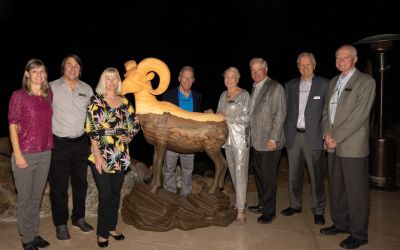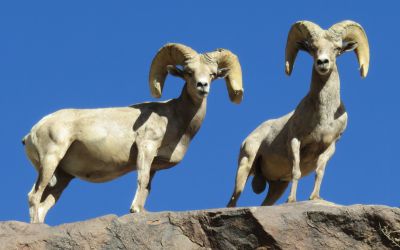 A recent grant from Inland Empire Community Foundation through The James and Rebecca Malachowski Charitable Fund is giving Bighorn Institute a new opportunity to roll smoothly into the future.
A recent grant from Inland Empire Community Foundation through The James and Rebecca Malachowski Charitable Fund is giving Bighorn Institute a new opportunity to roll smoothly into the future.
Quite literally, in fact.
“We’re totally privately funded, so every grant is meaningful and helpful,” said Aimee J. Byard, Biologist and the Director of Operations for Bighorn Institute. “Specifically, this grant helped us because we just had the rear axle break on our main field vehicle. That was unexpected, and the grant came at time when it could be an incredible help because that vehicle is how we do our field work.”
“A huge part of our research is being able to get out into the field,” she added.
The research component is significant at Bighorn Institute as workers are out in the field daily.
“We’re tracking three herds from Palm Springs to La Quinta,” Byard said. “We have done this work for 42 years, and we provide vital management data to the state and federal wildlife agencies.”
One key research component is tracking reproduction, which allows the nonprofit to determine the status of the sheep population.
“We’re able to see then how reproduction is going, for instance, and if lambs are surviving,” Byard added. “Understanding the population growth is very important in determining management needs for the species. We’re also looking at the urban health and behavior of the sheep.”
One discovery found that sheep are now using the urban fringe more in several of the populations tracked, which gives Bighorn a clearer picture of the current reality and how to better serve the population and relay that information.
To be sure, Bighorn Institute has become one of the few organizations in Valley to be held with such reverence. Created in 1982 by a group of biologists and veterinarians, the primary goal was to investigate the causes of bighorn sheep declines, honing in on Peninsular desert bighorn sheep (Ovis canadensis).
The Institute has conducted a Captive Breeding and Wild Population Augmentation Program to provide genetic and demographic support to declining Peninsular bighorn populations. Thus far, it has kept two local herds from completely disappearing—the San Jacinto and northern Santa Rosa Mountain herds.
Between its many research projects and community activities, which include sheep-spotting hikes, bighorn talks, and other components, the nonprofit has done a stellar job with its community outreach. To that end its “Citizen Scientist” stands out.
The program allows people to help Bighorn document the sheep in the mountains from Palm Springs to La Quinta. As for funding Bighorn Institute’s many programs, resources are derived from individual contributions, private foundations, and public sector grants.
Looking back across the last year, Byard points out a significant event that will inform future research.
“We’ve had a very unique double lambing season,” she said. “In our over 40 years of research, it’s an incredibly unique thing where sheep give birth twice in the same calendar year. Typically, the sheep might lose their first lamb and then give birth again if the environmental conditions are good. But in some cases this past year, they haven’t lost their lamb and they’ve still given birth twice. It’s really incredible.”

This is one of the benefits when you have a nonprofit in the field daily intensely researching.
“You see these things, whereas most people wouldn’t be looking for lambs at this time because it’s not technically lambing season,” Byard said. “We’re anxious to see how they survive moving into 2025 and how that lambing season goes.”
Ways for the public to get involved abound. Between various fundraisers and visiting the Bighorn Institute resale store (in The Antique Galleries of Palm Springs), the Adopt-A-Bighorn program has gained great traction.
In the mood to adopt a lamb for $100? How about a ewe or ram for $150 each? The year-long adoption entitles individuals to an adoption certificate, photos, a fact sheet and an e-newsletter subscription.
And, considering that Peninsular bighorn sheep have been state listed as “rare” since 1971, and were listed as a federal endangered species in 1998, another great way to support research is to become a Bighorn Institute member. Check the website for full details on the process.
Learn more at bighorninstitute.org.
This story originally appeared in the Desert Sun, January 2025.
Stay up to date on all the good work we’re doing through the power of philanthropy. Sign up for our eNewsletter, Philanthropy Matters, today.


